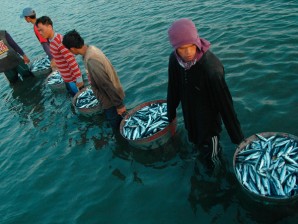Don’t belittle ‘GG’: It’s now imported
“Galunggong,” or round scad, once considered the poor man’s fish, is now among the marine products the Philippines is importing.
Part of the country’s galunggong supply now comes from either China or Taiwan, according to the Bureau of Fisheries and Aquatic Resources (BFAR).
Fish accounts for 80 percent of the animal protein intake of Filipinos, who each eat 28 kilos of fish annually.
BFAR Director Asis Perez said the agency and the Department of Agriculture were compelled to open the domestic market to imported fish because of the declining fish catch.
The national stock assessment program of BFAR shows that 10 of the 13 fishing grounds that were mapped are “very heavily exploited.” These areas have more than 70 fishermen per square kilometer.
Article continues after this advertisementOnly the Pacific seaboard and Macajalar Bay in northeastern Mindanao have an abundant fish supply, Perez said.
Article continues after this advertisement“These areas are not overexploited yet. The rest needs to be fixed because there is an indication of a decline,” he said yesterday on the sidelines of a forum on environment at the University of the Philippines in Diliman, Quezon City.
Because the Philippines is struggling to meet the demand for fish the government is keen on “formalizing” fish importation, Perez said.
About 900,000 metric tons of imported fish enter the country every year, he said. Most of the imports are for institutional buyers who process seafood.
However, some fish like galunggong, “tulingan” (frigate tuna or Auxis thazard), and “hasa-hasa” (short-bodied mackerel) end up in the wet markets too, Perez said.
Sources of protein
These fish species, which are known to be cheap sources of protein, come from China and Taiwan, he noted.
Fish production in the Philippines is estimated at 6 million MT a year. About 55 percent comes from aquaculture and the rest is caught in the seas. Of the aquaculture production, 40 percent is fish. Seaweeds account for the rest, Perez said.
Agriculture Secretary Proceso Alcala recently said the Philippines would have to formally open its market to fish from abroad.

Import quota
Perez said there would be a quota for imported fish to limit the amount to be sold in the wet markets.
In 2011, the fisheries subsector’s performance was dismal. The agriculture department said the subsector, which accounted for 20.7 percent of the total agriculture output, contracted by 4.1 percent.
“Commercial and municipal fish catch declined due to overfishing, illegal fishing, and rough seas and strong winds during the second semester caused by several typhoons,” the agriculture department said.
To remedy overfishing, the department imposed a closed season on species like tuna and sardines, the country’s two major fish exports.
Poverty among fishers
The activist fisherfolk group, Pamalakaya, meanwhile, has asked the Food and Agriculture Organization (FAO) to investigate the incidence of poverty in small fishers and the destruction of the country’s fishing grounds.
“We collectively send this strong appeal to officials of the UN FAO to come to the Philippines and have a self-discovery on why small-scale fisherfolk belong to the poorest of the poor in the country. The reality check can be found and heard from the voices from the grassroots,” said Pamalakaya national chair Fernando Hicap.
Hicap said the UN special rapporteur on the right to food, Oliver de Schutter, should investigate the various projects that could destroy the livelihood and fish supply of Filipino fishers.
In a consultation with FAO officials Monday, Pamalakaya said about 300,000 fish workers in the country worked like slaves inside aquaculture farms and aboard commercial fishing vessels.
The group said fish workers were receiving an average of P200 a day way below the minimum wage of P427.
